Please note that, as of 1 January 2016, Chromatography has been renamed to Separations and is now published here.
Journal Description
Chromatography
Chromatography
is an international, scientific, peer-reviewed, open access journal of separation science published quarterly online by MDPI. Note that from Volume 3, Chromatography has been renamed Separations.
- Open Access - free for readers, with article processing charges (APC) paid by authors or their institutions.
- Rapid publication: manuscripts are peer-reviewed and a first decision is provided to authors approximately 31 days after submission; acceptance to publication is undertaken in 8 days (median values for papers published in this journal in 2015).
- Recognition of Reviewers: reviewers who provide timely, thorough peer-review reports receive vouchers entitling them to a discount on the APC of their next publication in any MDPI journal, in appreciation of the work done.
Latest Articles
Uncertainty of Blood Alcohol Concentration (BAC) Results as Related to Instrumental Conditions: Optimization and Robustness of BAC Analysis Headspace Parameters
Chromatography 2015, 2(4), 691-708; https://doi.org/10.3390/chromatography2040691 - 11 Dec 2015
Cited by 5
Abstract
►
Show Figures
Analysis of blood alcohol concentration is a routine analysis performed in many forensic laboratories. This analysis commonly utilizes static headspace sampling, followed by gas chromatography combined with flame ionization detection (GC-FID). Studies have shown several “optimal” methods for instrumental operating conditions, which are
[...] Read more.
Analysis of blood alcohol concentration is a routine analysis performed in many forensic laboratories. This analysis commonly utilizes static headspace sampling, followed by gas chromatography combined with flame ionization detection (GC-FID). Studies have shown several “optimal” methods for instrumental operating conditions, which are intended to yield accurate and precise data. Given that different instruments, sampling methods, application specific columns and parameters are often utilized, it is much less common to find information on the robustness of these reported conditions. A major problem can arise when these “optimal” conditions may not also be robust, thus producing data with higher than desired uncertainty or potentially inaccurate results. The goal of this research was to incorporate the principles of quality by design (QBD) in the adjustment and determination of BAC (blood alcohol concentration) instrumental headspace parameters, thereby ensuring that minor instrumental variations, which occur as a matter of normal work, do not appreciably affect the final results of this analysis. This study discusses both the QBD principles as well as the results of the experiments, which allow for determination of more favorable instrumental headspace conditions. Additionally, method detection limits will also be reported in order to determine a reporting threshold and the degree of uncertainty at the common threshold value of 0.08 g/dL. Furthermore, the comparison of two internal standards, n-propanol and t-butanol, will be investigated. The study showed that an altered parameter of 85 °C headspace oven temperature and 15 psi headspace vial pressurization produces the lowest percent relative standard deviation of 1.3% when t-butanol is implemented as an internal standard, at least for one very common platform. The study also showed that an altered parameter of 100 °C headspace oven temperature and 15-psi headspace vial pressurization produces the lowest MDL of 0.00002 g/dL when n-propanol is implemented as an internal standard. These altered headspace parameters have the potential to produce more precise and accurate BAC determination.
Full article
Open AccessArticle
Measurement and Modeling of Extra-Column Effects Due to Injection and Connections in Capillary Liquid Chromatography
by
James P. Grinias, Bernard Bunner, Martin Gilar and James W. Jorgenson
Chromatography 2015, 2(4), 669-690; https://doi.org/10.3390/chromatography2040669 - 1 Dec 2015
Cited by 32
Abstract
As column volumes continue to decrease, extra-column band broadening has become an increasingly important consideration when determining column performance. Combined contributions due to the injector and connecting tubing in a capillary LC system were measured and found to be larger than expected by
[...] Read more.
As column volumes continue to decrease, extra-column band broadening has become an increasingly important consideration when determining column performance. Combined contributions due to the injector and connecting tubing in a capillary LC system were measured and found to be larger than expected by Taylor-Aris theory. Variance from sigma-type and tau-type broadening was isolated from eluted peaks using the Foley-Dorsey Exponentially Modified Gaussian peak fitting model and confirmed with computational fluid dynamics. It was found that the tau-type contributions were the main cause for the excessive broadening because of poorly-swept volumes at the connection between the injector and tubing. To reduce tau-type contributions (and peak tailing), a timed pinch mode could be used for analyte injection.
Full article
(This article belongs to the Special Issue Advances in High Pressure Liquid Chromatography)
►▼
Show Figures
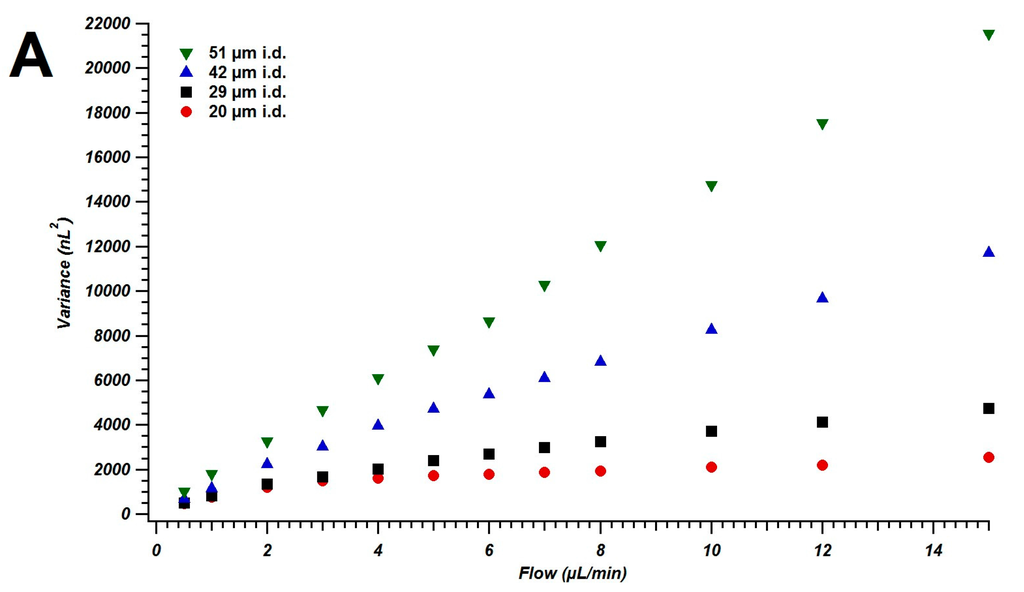
Figure 1
Open AccessArticle
Hyphenation of Field-Flow Fractionation and Magnetic Particle Spectroscopy
by
Norbert Löwa, Patricia Radon, Dirk Gutkelch, Rinaldo August and Frank Wiekhorst
Chromatography 2015, 2(4), 655-668; https://doi.org/10.3390/chromatography2040655 - 25 Nov 2015
Cited by 11
Abstract
Magnetic nanoparticles (MNPs) exhibit unique magnetic properties making them ideally suited for a variety of biomedical applications. Depending on the desired magnetic effect, MNPs must meet special magnetic requirements which are mainly determined by their structural properties (e.g., size distribution). The hyphenation of
[...] Read more.
Magnetic nanoparticles (MNPs) exhibit unique magnetic properties making them ideally suited for a variety of biomedical applications. Depending on the desired magnetic effect, MNPs must meet special magnetic requirements which are mainly determined by their structural properties (e.g., size distribution). The hyphenation of chromatographic separation techniques with complementary detectors is capable of providing multidimensional information of submicron particles. Although various methods have already been combined for this approach, so far, no detector for the online magnetic analysis was used. Magnetic particle spectroscopy (MPS) has been proven a straightforward technique for specific quantification and characterization of MNPs. It combines high sensitivity with high temporal resolution; both of these are prerequisites for a successful hyphenation with chromatographic separation. We demonstrate the capability of MPS to specifically detect and characterize MNPs under usually applied asymmetric flow field-flow fractionation (A4F) conditions (flow rates, MNP concentration, different MNP types). To this end MPS has been successfully integrated into an A4F multidetector platform including dynamic ligth scattering (DLS), multi-angle light scattering (MALS) and ultraviolet (UV) detection. Our system allows for rapid and comprehensive characterization of typical MNP samples for the systematic investigation of structure-dependent magnetic properties. This has been demonstrated by magnetic analysis of the commercial magnetic resonance imaging (MRI) contrast agent Ferucarbotran (FER) during hydrodynamic A4F fractionation.
Full article
(This article belongs to the Special Issue Field-Flow Fractionation)
►▼
Show Figures

Graphical abstract
Open AccessTechnical Note
Simultaneous High Performance Liquid Chromatography Assay of Pentoxifylline, Mupirocin, Itraconazole, and Fluticasone Propionate in Humco™ Lavare Wound Base
by
Troy Purvis
Chromatography 2015, 2(4), 642-654; https://doi.org/10.3390/chromatography2040642 - 11 Nov 2015
Cited by 3
Abstract
►▼
Show Figures
This article details the elements used in the method verification for the simultaneous high performance liquid chromatography (HPLC) assay of Pentoxifylline, Mupirocin, Itraconazole, and Fluticasone Propionate in Humco™ Lavare Wound base. The method was proven to be linear over 50%–150% of the nominal
[...] Read more.
This article details the elements used in the method verification for the simultaneous high performance liquid chromatography (HPLC) assay of Pentoxifylline, Mupirocin, Itraconazole, and Fluticasone Propionate in Humco™ Lavare Wound base. The method was proven to be linear over 50%–150% of the nominal concentration of the standards. The method was proven to be accurate over 50%–150%, with 98%–102% recovery of the actives from spiked placeboes over that range. The method was shown to be specific to the analytes listed and precise, yielding acceptable results for system reproducibility and method repeatability. The method, as written, is considered to have been verified.
Full article
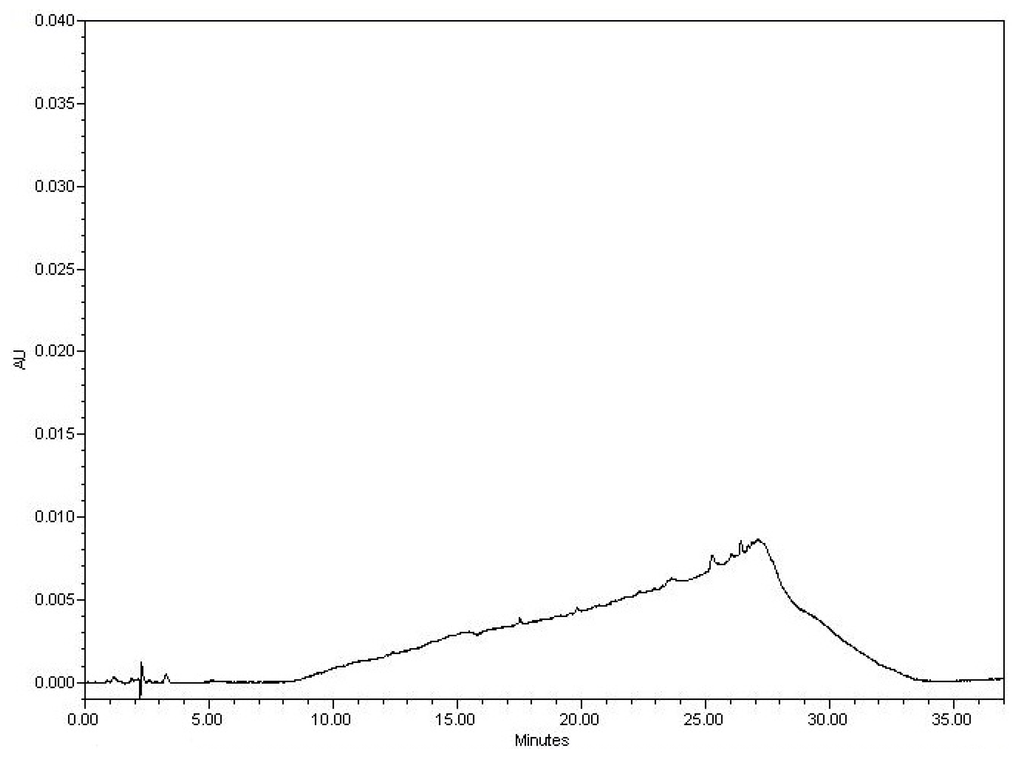
Figure 1
Open AccessArticle
Prediction of Peak Shape and Characterization of Column Performance in Liquid Chromatography as a Function of Flow Rate
by
Juan José Baeza-Baeza, Casandra Ortiz-Bolsico and María Celia García-Alvarez-Coque
Chromatography 2015, 2(4), 625-641; https://doi.org/10.3390/chromatography2040625 - 2 Nov 2015
Cited by 2
Abstract
►▼
Show Figures
Traditionally, column performance in liquid chromatography has been studied using information from the elution of probe compounds at different flow rates through van Deemter plots, which relate the column plate height to the linear mobile phase velocity. A more recent approach to characterize
[...] Read more.
Traditionally, column performance in liquid chromatography has been studied using information from the elution of probe compounds at different flow rates through van Deemter plots, which relate the column plate height to the linear mobile phase velocity. A more recent approach to characterize columns is the representation of the peak widths (or the right and left peak half-widths) for a set of compounds versus their retention times, which, for isocratic elution, give rise to almost linear plots. In previous work, these plots have been shown to facilitate the prediction of peak profiles (width and asymmetry) with optimization purposes. In this work, a detailed study on the dependence of the peak widths (or half-widths) on the flow rate is reported. A new approach to quantify the deterioration of column performance for slow and fast flow rates and to characterize chromatographic columns is proposed. The approach makes use of the width (or half-widths) for a set of compounds with similar interaction kinetics and does not require knowledge of the extra-column contributions to the total variance. The chromatographic data of two sets of compounds of different natures (sulfonamides and β-blockers), eluted from Spherisorb and Chromolith columns with acetonitrile-water mixtures, are used to illustrate the approach.
Full article
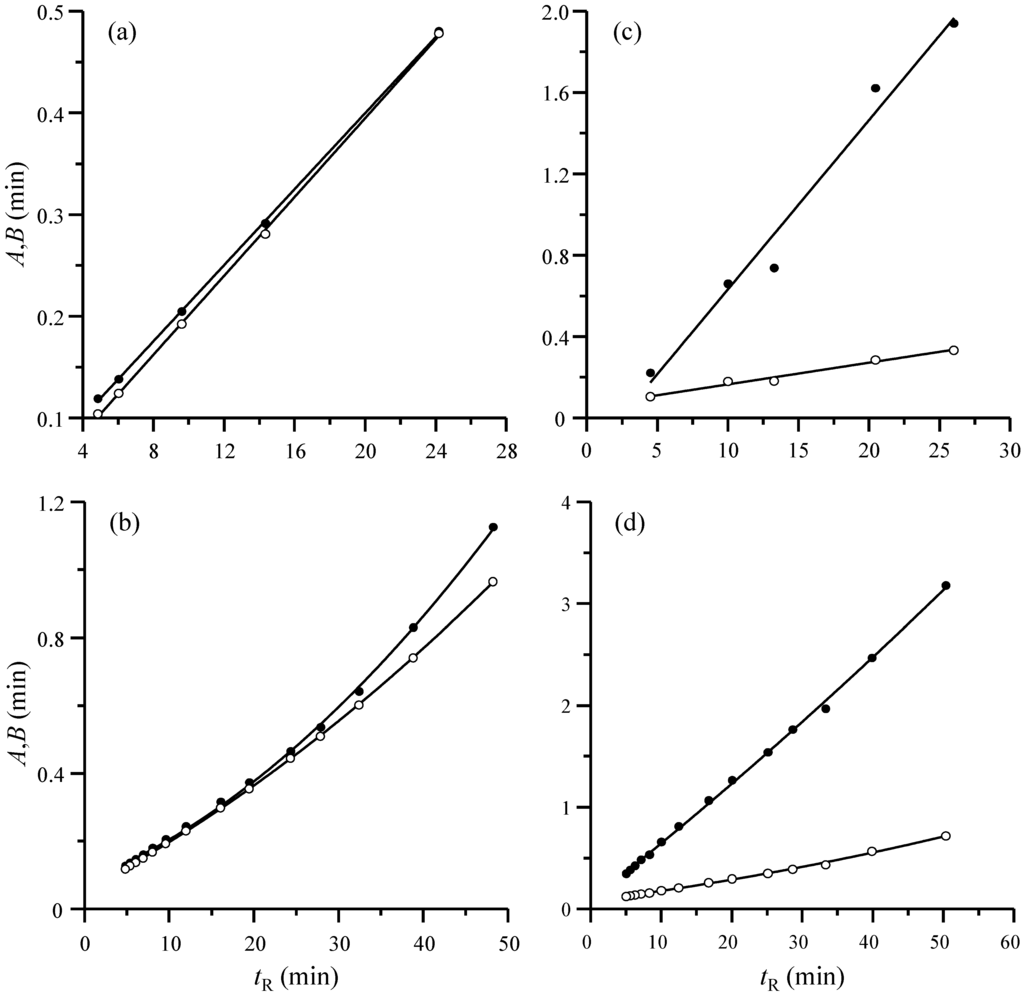
Figure 1
Open AccessArticle
Modeling Compound Loss from Polydimethylsiloxane Passive Samplers
by
Courtney L. Thomas and Danny D. Reible
Chromatography 2015, 2(4), 611-624; https://doi.org/10.3390/chromatography2040611 - 12 Oct 2015
Cited by 10
Abstract
Volatile losses were measured from polydimethylsiloxane (PDMS) passive samplers during determination of contaminant porewater concentrations in sediments. Volatile losses could occur between the time of retrieval and processing of the passive sampler or in intertidal environments where the passive sampler could potentially be
[...] Read more.
Volatile losses were measured from polydimethylsiloxane (PDMS) passive samplers during determination of contaminant porewater concentrations in sediments. Volatile losses could occur between the time of retrieval and processing of the passive sampler or in intertidal environments where the passive sampler could potentially be exposed above the water surface at low tide. A model was developed to predict losses of absorbed compounds as a function of sorbent geometry and the Henry’s Law Coefficient and PDMS-water partition coefficient of the compound of interest. The model suggests that thin layers of PDMS typically used to minimize equilibration times in passive sampling (≤30 µm) may not provide quantitative measurement of naphthalenes or other lighter volatile compounds without special efforts to reduce losses. The results suggest that the samplers should be processed rapidly onsite or kept at low temperatures after retrieval to maximize retention of more volatile compounds or designed with thick PDMS layers. The results also suggest that less volatile compounds, including phenanthrene, and higher molecular weight polynuclear aromatic hydrocarbons (PAHs) exhibit minimal evaporative losses with typical sample processing times.
Full article
(This article belongs to the Special Issue Solid Phase Micro-Extraction)
►▼
Show Figures
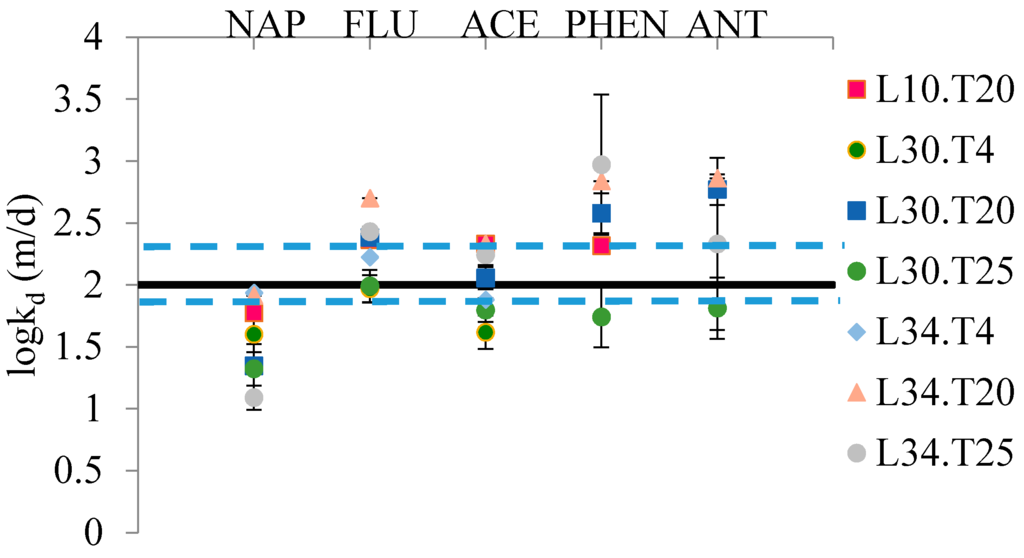
Figure 1
Open AccessArticle
Particle Based Modeling of Electrical Field Flow Fractionation Systems
by
Tonguc O. Tasci, William P. Johnson, Diego P. Fernandez, Eliana Manangon and Bruce K. Gale
Chromatography 2015, 2(4), 594-610; https://doi.org/10.3390/chromatography2040594 - 9 Oct 2015
Cited by 5
Abstract
Electrical Field Flow Fractionation (ElFFF) is a sub method in the field flow fractionation (FFF) family that relies on an applied voltage on the channel walls to effect a separation. ElFFF has fallen behind some of the other FFF methods because of the
[...] Read more.
Electrical Field Flow Fractionation (ElFFF) is a sub method in the field flow fractionation (FFF) family that relies on an applied voltage on the channel walls to effect a separation. ElFFF has fallen behind some of the other FFF methods because of the optimization complexity of its experimental parameters. To enable better optimization, a particle based model of the ElFFF systems has been developed and is presented in this work that allows the optimization of the main separation parameters, such as electric field magnitude, frequency, duty cycle, offset, flow rate and channel dimensions. The developed code allows visualization of individual particles inside the separation channel, generation of realistic fractograms, and observation of the effects of the various parameters on the behavior of the particle cloud. ElFFF fractograms have been generated via simulations and compared with experiments for both normal and cyclical ElFFF. The particle visualizations have been used to verify that high duty cycle voltages are essential to achieve long retention times and high resolution separations. Furthermore, by simulating the particle motions at the channel outlet, it has been demonstrated that the top channel wall should be selected as the accumulation wall for cyclical ElFFF to reduce band broadening and achieve high efficiency separations. While the generated particle based model is a powerful tool to estimate the outcomes of the ElFFF experiments and visualize particle motions, it can also be used to design systems with new geometries which may lead to the design of higher efficiency ElFFF systems. Furthermore, this model can be extended to other FFF techniques by replacing the electrical field component of the model with the fields used in the other FFF techniques.
Full article
(This article belongs to the Special Issue Field-Flow Fractionation)
►▼
Show Figures
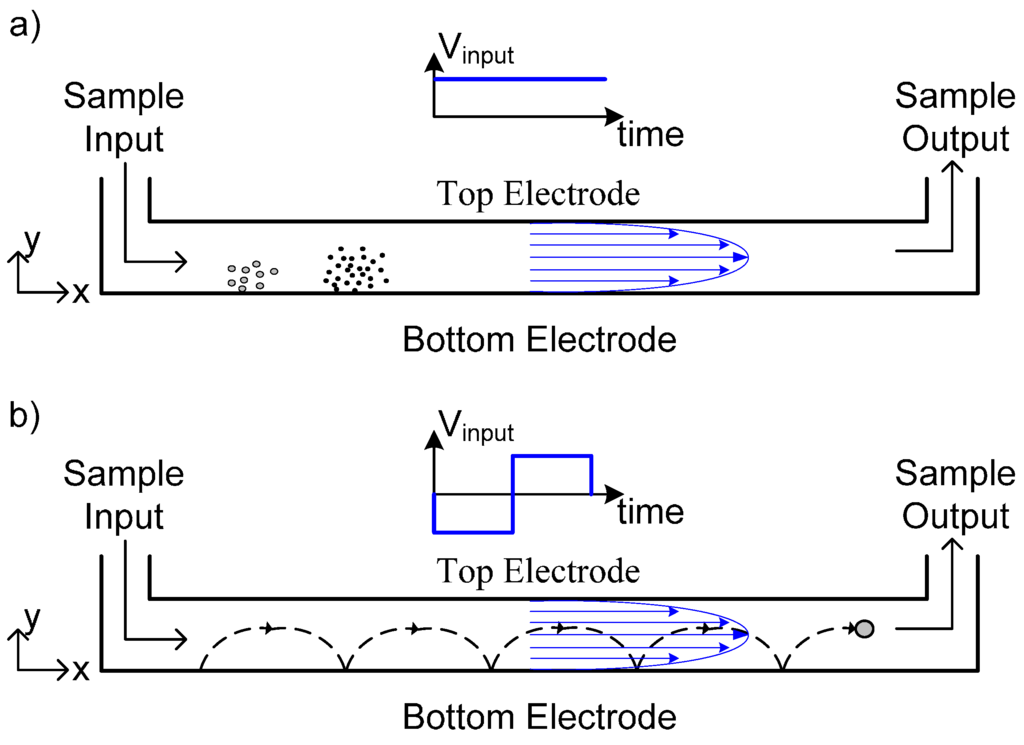
Figure 1
Open AccessArticle
Conductivity-Dependent Flow Field-Flow Fractionation of Fulvic and Humic Acid Aggregates
by
Martha J. M. Wells
Chromatography 2015, 2(3), 580-593; https://doi.org/10.3390/chromatography2030580 - 22 Sep 2015
Cited by 11
Abstract
Fulvic (FAs) and humic acids (HAs) are chemically fascinating. In water, they have a strong propensity to aggregate, but this research reveals that tendency is regulated by ionic strength. In the environment, conductivity extremes occur naturally—freshwater to seawater—warranting consideration at low and high
[...] Read more.
Fulvic (FAs) and humic acids (HAs) are chemically fascinating. In water, they have a strong propensity to aggregate, but this research reveals that tendency is regulated by ionic strength. In the environment, conductivity extremes occur naturally—freshwater to seawater—warranting consideration at low and high values. The flow field flow fractionation (flow FFF) of FAs and HAs is observed to be concentration dependent in low ionic strength solutions whereas the corresponding flow FFF fractograms in high ionic strength solutions are concentration independent. Dynamic light scattering (DLS) also reveals insight into the conductivity-dependent behavior of humic substances (HSs). Four particle size ranges for FAs and humic acid aggregates are examined: (1) <10 nm; (2) 10 nm–6 µm; (3) 6–100 µm; and (4) >100 µm. Representative components of the different size ranges are observed to dynamically coexist in solution. The character of the various aggregates observed—such as random-extended-coiled macromolecules, hydrogels, supramolecular, and micellar—as influenced by electrolytic conductivity, is discussed. The disaggregation/aggregation of HSs is proposed to be a dynamic equilibrium process for which the rate of aggregate formation is controlled by the electrolytic conductivity of the solution.
Full article
(This article belongs to the Special Issue Field-Flow Fractionation)
►▼
Show Figures
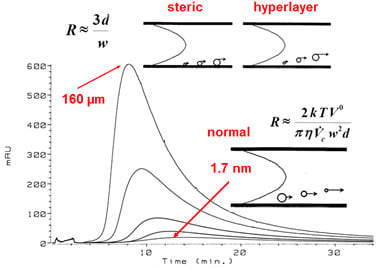
Graphical abstract
Open AccessArticle
Nanoparticle-Surface Interactions in Geometrical Separation Devices
by
Anthony P. Malanoski, Brandy J. Johnson, Jeffrey S. Erickson, Carrie K. Sun, Connie S. Scoggins, Mansoor Nasir, Jason E. Bongard and Martin H. Moore
Chromatography 2015, 2(3), 567-579; https://doi.org/10.3390/chromatography2030567 - 11 Sep 2015
Abstract
►▼
Show Figures
This study sought to demonstrate the impact of surface-target interactions in a device bearing geometrical features through evaluations of chemical modification to the surface and alteration of the charge state of both surface and targets. The movement of commercial fluorescent nanoparticles through a
[...] Read more.
This study sought to demonstrate the impact of surface-target interactions in a device bearing geometrical features through evaluations of chemical modification to the surface and alteration of the charge state of both surface and targets. The movement of commercial fluorescent nanoparticles through a field of geometric features was monitored based on the output of the field measured at different points transverse to the direction of flow. Modification of the device surfaces using carboxylate, amine, phenyl, and fluorinated groups was considered. The functional group on the surface was found to significantly impact biased particle movement in the device with amine groups leading to the greatest differences. Other factors, such as flow rate, pH, and initial particle concentration, were also found to have a significant impact on particle concentrations across the feature field.
Full article

Graphical abstract
Open AccessArticle
Synthetic Smectite Colloids: Characterization of Nanoparticles after Co-Precipitation in the Presence of Lanthanides and Tetravalent Elements (Zr, Th)
by
Muriel Bouby, Nicolas Finck and Horst Geckeis
Chromatography 2015, 2(3), 545-566; https://doi.org/10.3390/chromatography2030545 - 1 Sep 2015
Cited by 2
Abstract
The magnesian smectite hectorite is a corrosion product frequently detected in nuclear waste glass alteration experiments. The structural incorporation of a single trivalent lanthanide was previously demonstrated. Hectorite was presently synthesized, for the first time, in the presence of several lanthanides (La, Eu,
[...] Read more.
The magnesian smectite hectorite is a corrosion product frequently detected in nuclear waste glass alteration experiments. The structural incorporation of a single trivalent lanthanide was previously demonstrated. Hectorite was presently synthesized, for the first time, in the presence of several lanthanides (La, Eu, Yb) following a multi-step synthesis protocol. The smallest-sized particles (nanoparticles, NPs) were isolated by centrifugation and analyzed by asymmetrical flow field-flow fractionation (AsFlFFF) coupled to ICP-MS, in order to obtain information on the elemental composition and distribution as a function of the size. Nanoparticles can be separated from the bulk smectite phase. The particles are able to accommodate even the larger-sized lanthanides such as La, however, with lower efficiency. We, therefore, assume that the incorporation proceeds by substitution for octahedral Mg accompanied by a concomitant lattice strain that increases with the size of the lanthanides. The presence of a mixture does not seem to affect the incorporation extent of any specific element. Furthermore, syntheses were performed where in addition the tetravalent zirconium or thorium elements were admixed, as this oxidation state may prevail for many actinide ions in a nuclear waste repository. The results show that they can be incorporated as well.
Full article
(This article belongs to the Special Issue Field-Flow Fractionation)
►▼
Show Figures
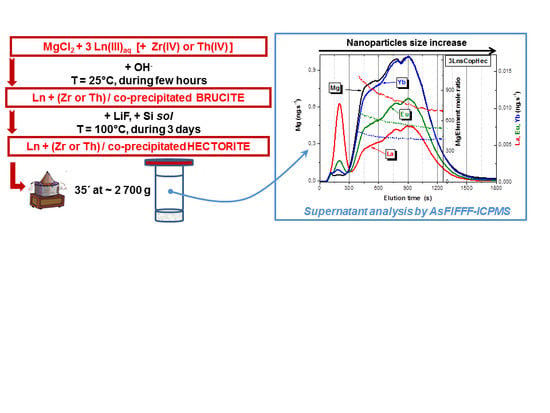
Graphical abstract
Open AccessArticle
The Dramatic Modulatory Role of the 2'N Substitution of the Terminal Amino Hexose of Globotetraosylceramide in Determining Binding by Members of the Verotoxin Family
by
Murugesapillai Mylvaganam, Beth Binnington, Monique Budani, Anna M. Soltyk and Clifford A. Lingwood
Chromatography 2015, 2(3), 529-544; https://doi.org/10.3390/chromatography2030529 - 14 Aug 2015
Cited by 1
Abstract
Although globotetraosylceramide (Gb4) is only recognized by a single member of the verotoxin family namely, the pig edema disease toxin (VT2e), removal of the acetyl group from the terminal N-acetyl hexosamine of Gb4 to generate the free amino sugar containing
[...] Read more.
Although globotetraosylceramide (Gb4) is only recognized by a single member of the verotoxin family namely, the pig edema disease toxin (VT2e), removal of the acetyl group from the terminal N-acetyl hexosamine of Gb4 to generate the free amino sugar containing species (aminoGb4) results in the generation of a glycolipid preferentially recognized by all members of the verotoxin family (i.e., VT1, VT2, VT2c, and VT2e). GT3, a site-specific mutant of VT2e, in which Gb4 recognition is lost but Gb3 binding is retained, also binds aminoGb4. We have now compared the binding of VT1, VT2, VT2e, and GT3 to a series of aminoGb4 derivatives using a TLC overlay technique. DimethylaminoGb4 is bound by VT1 and VT2 but not VT2e or GT3; formylaminoGb4 binds all toxins but poorly to VT2 and preferentially VT2e; trifluoroacetylaminoGb4 binds only VT2e and GT3; isopropylaminoGb4 binds VT1 and poorly to VT2; benzylaminoGb4 binds all four toxins. Thus, there is a marked distinction between the permissible amino substitutions for VT1 and VT2e binding. GT3 is a hybrid between these in that, according to the substitution, it behaves similarly either to VT1 or to VT2e. For each species, GT3 does not however, show a hybrid binding between that of VT1 and VT2e. Analysis of the binding as a function of pH shows opposite effects for VT1 and VT2e: decreased pH increases VT1, but decreases VT2e receptor glycolipid binding.
Full article
(This article belongs to the Special Issue New Trends in Thin-Layer Chromatography)
►▼
Show Figures
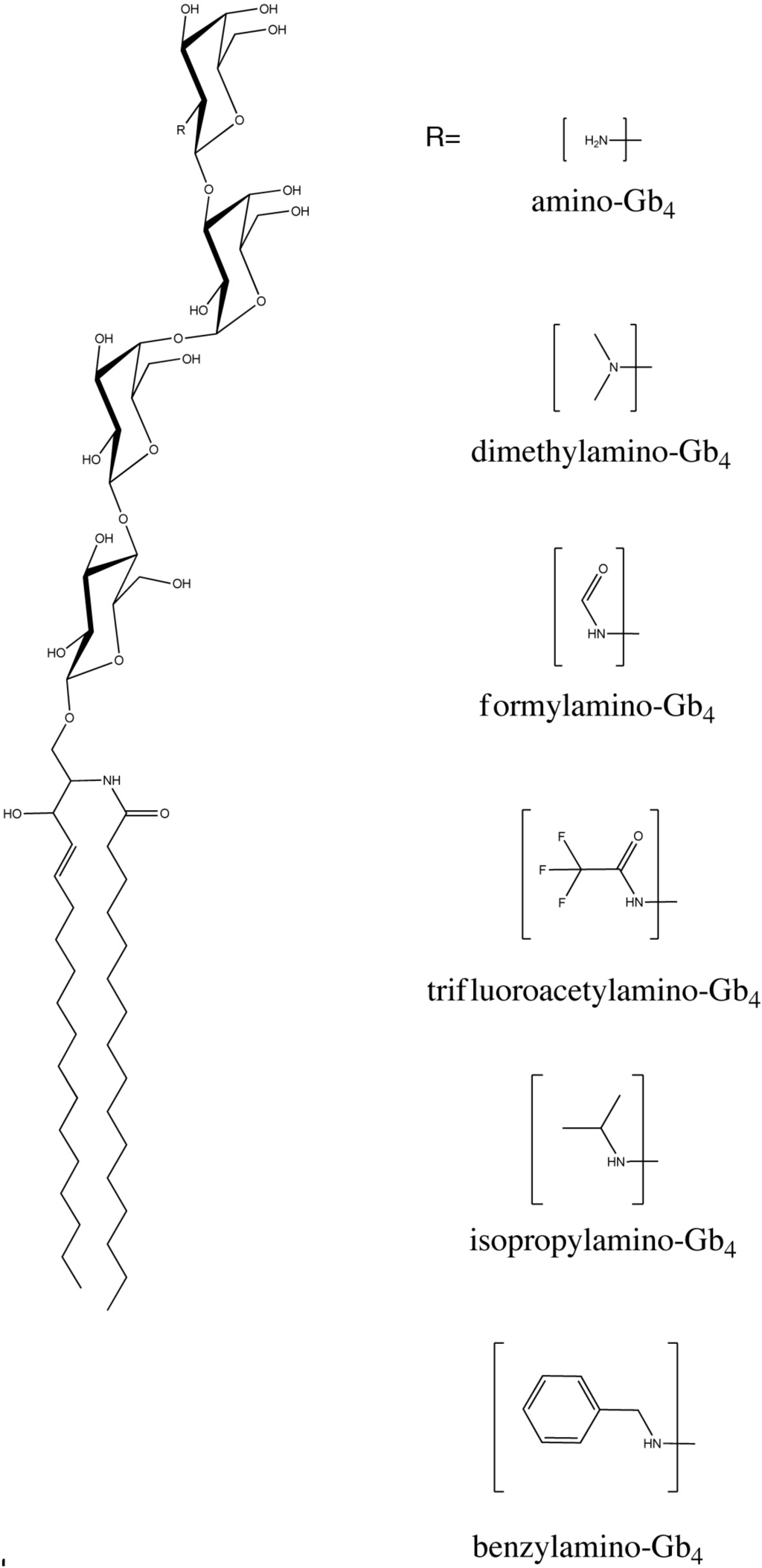
Figure 1
Open AccessArticle
Evaluation of Carbon Nanotubes Functionalized Polydimethylsiloxane Based Coatings for In-Tube Solid Phase Microextraction Coupled to Capillary Liquid Chromatography
by
Neus Jornet-Martínez, Pascual Serra-Mora, Yolanda Moliner-Martínez, Rosa Herráez-Hernández and Pilar Campíns-Falcó
Chromatography 2015, 2(3), 515-528; https://doi.org/10.3390/chromatography2030515 - 10 Aug 2015
Cited by 11
Abstract
In the present work, the performance of carbon nanotubes (c-CNTs) functionalized polydimethylsiloxane (PDMS) based coatings as extractive phases for in-tube solid phase microextraction (IT-SPME) coupled to Capillary LC (CapLC) has been evaluated. Carboxylic-single walled carbon nanotubes (c-SWNTs) and carboxylic-multi walled carbon nanotubes (c-MWNTs)
[...] Read more.
In the present work, the performance of carbon nanotubes (c-CNTs) functionalized polydimethylsiloxane (PDMS) based coatings as extractive phases for in-tube solid phase microextraction (IT-SPME) coupled to Capillary LC (CapLC) has been evaluated. Carboxylic-single walled carbon nanotubes (c-SWNTs) and carboxylic-multi walled carbon nanotubes (c-MWNTs) have been immobilized on the activated surface of PDMS capillary columns. The effect of different percentages of diphenyl groups in the PDMS extractive phase has also been evaluated. The extraction capability of the capillary columns has been tested for different organic pollutants, nitrogen heterocyclic compounds and polycyclic aromatic compounds (PAHs). The results indicated that the use of the c-CNTs-PDMS capillary columns improve pyriproxyfen and mainly PAH extraction. Triazines were better extracted by unmodified TRB-35 and modified c-CNTs-PDMSTRB-5. The results showed that the extraction capability of the c-CNT capillary columns depends not only on the polarity of the analytes (as it occurs with PDMS columns) but also on the interactions that the analytes can establish with the immobilized c-CNTs on the PDMS columns. The extraction efficiency has been evaluated on the basis of the preconcentration rate that can be achieved, and, in this sense, the best c-CNTs-PDMS capillary column for each group of compounds can be proposed.
Full article
(This article belongs to the Special Issue Solid Phase Micro-Extraction)
►▼
Show Figures
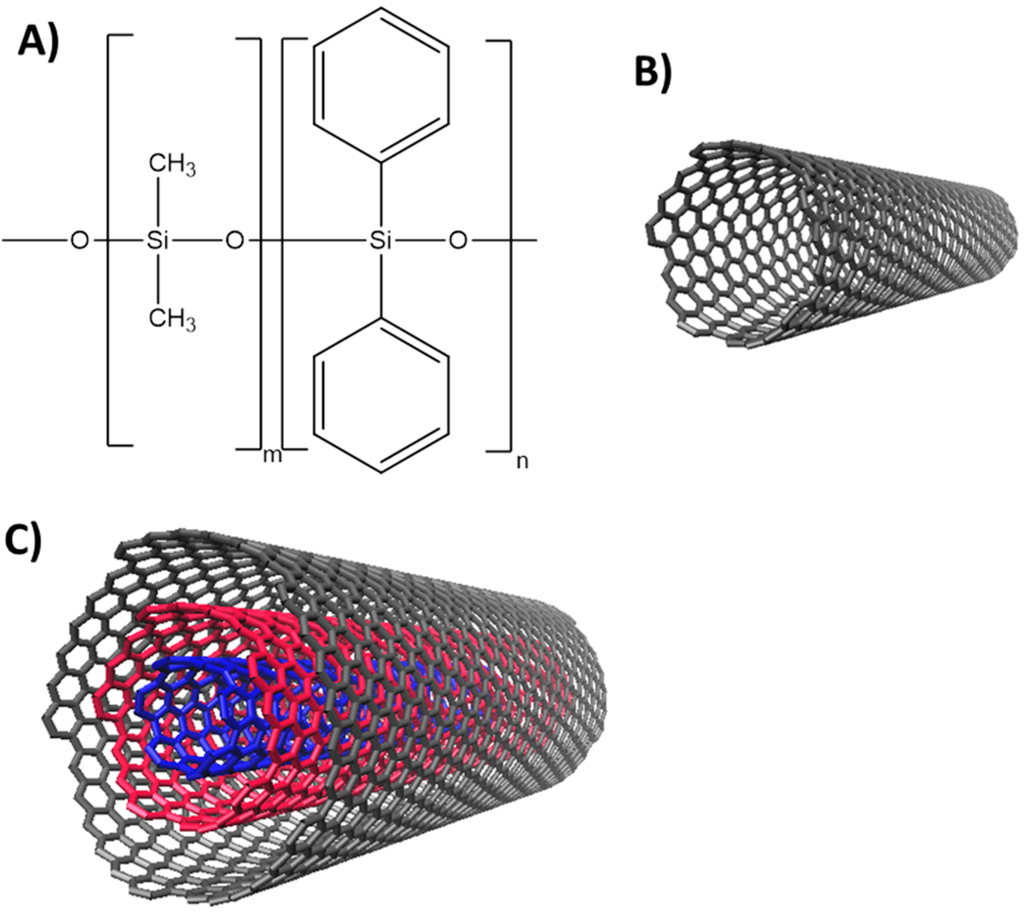
Figure 1
Open AccessArticle
Evaluation of 5 μm Superficially Porous Particles for Capillary and Microfluidic LC Columns
by
James P. Grinias and Robert T. Kennedy
Chromatography 2015, 2(3), 502-514; https://doi.org/10.3390/chromatography2030502 - 4 Aug 2015
Cited by 8
Abstract
Large-size (4–5 µm) superficially porous particles yield lower plate heights (e.g., the minimal reduced plate height or hmin ≈ 1.5) than fully porous particles of a similar size when packed into large-bore columns. This property allows for better chromatographic performance without the
[...] Read more.
Large-size (4–5 µm) superficially porous particles yield lower plate heights (e.g., the minimal reduced plate height or hmin ≈ 1.5) than fully porous particles of a similar size when packed into large-bore columns. This property allows for better chromatographic performance without the higher pressures required for smaller particles. This study explores the use of such particles in microfluidic LC columns where materials and fitting pressure limits can constrain the size of particle used. The theoretically predicted performance improvements compared to fully porous particles were not demonstrated in capillary columns (with hmin ≈ 2 for both particle types), in agreement with previous studies that examined smaller superficially porous particles. Microfluidic columns were then compared to capillary columns. Capillary columns significantly outperformed microfluidic columns due to imperfections imposed by microfluidic channel asymmetry and world-to-chip connection at the optimal flow rate; however, superficially porous particles packed in microfluidic LC columns had flatter plate height versus flow rate curves indicating potential for better performance at high reduced velocities.
Full article
(This article belongs to the Special Issue Microscale Separation and Analysis)
►▼
Show Figures
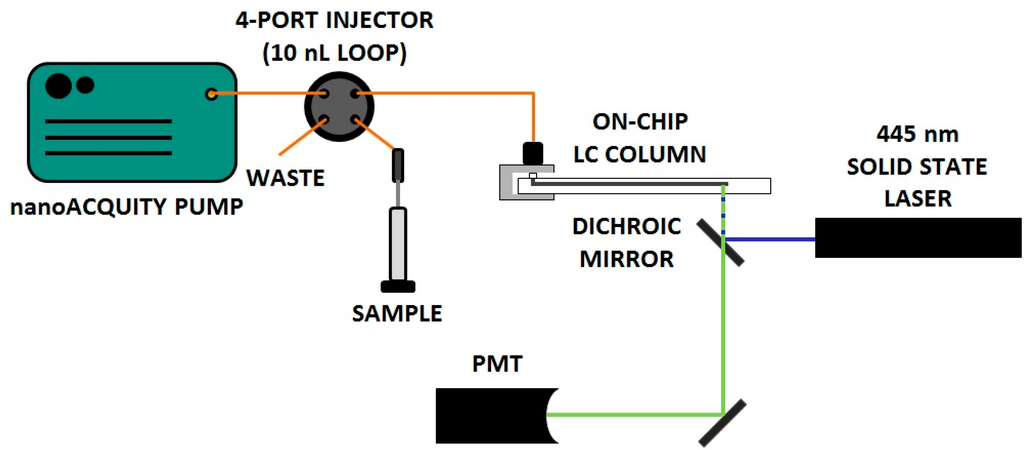
Figure 1
Open AccessArticle
A Novel Micro Pressurized Liquid Extraction Method for Rapid Sample Preparation of Polycyclic Aromatic Hydrocarbons in Various Solids
by
Jackson J. Frantz, Fadi L. Alkhateeb and Kevin B. Thurbide
Chromatography 2015, 2(3), 488-501; https://doi.org/10.3390/chromatography2030488 - 3 Aug 2015
Cited by 4
Abstract
The use of a novel micro pressurized liquid extraction (µPLE) method for the isolation of 16 priority pollutant polycyclic aromatic hydrocarbons (PAHs) from various solid samples is explored. The technique employs rapid heating in a single static extraction mode to remove analytes in
[...] Read more.
The use of a novel micro pressurized liquid extraction (µPLE) method for the isolation of 16 priority pollutant polycyclic aromatic hydrocarbons (PAHs) from various solid samples is explored. The technique employs rapid heating in a single static extraction mode to remove analytes in a matter of seconds from 5–10 mg samples using only 125 µL of solvent. For example, results show that 30 s extractions with toluene at 200 °C produce respective PAH recovery ranges of 90%–130% and 88%–114% from samples of soil and smoked chicken. Comparatively, solids containing significant amounts of biochar were more challenging to extract from. For instance, when using a pure biochar sample matrix, recoveries for the 16 PAHs range from only 33%–66% after 60 s of extraction with toluene at 200 °C. Overall, these extraction results agree very well with those reported when using conventional methods on similar samples. Therefore, the findings indicate that µPLE can potentially provide an alternative sample preparation method for PAHs that is both very rapid and requires little solvent.
Full article
(This article belongs to the Special Issue Microscale Separation and Analysis)
►▼
Show Figures
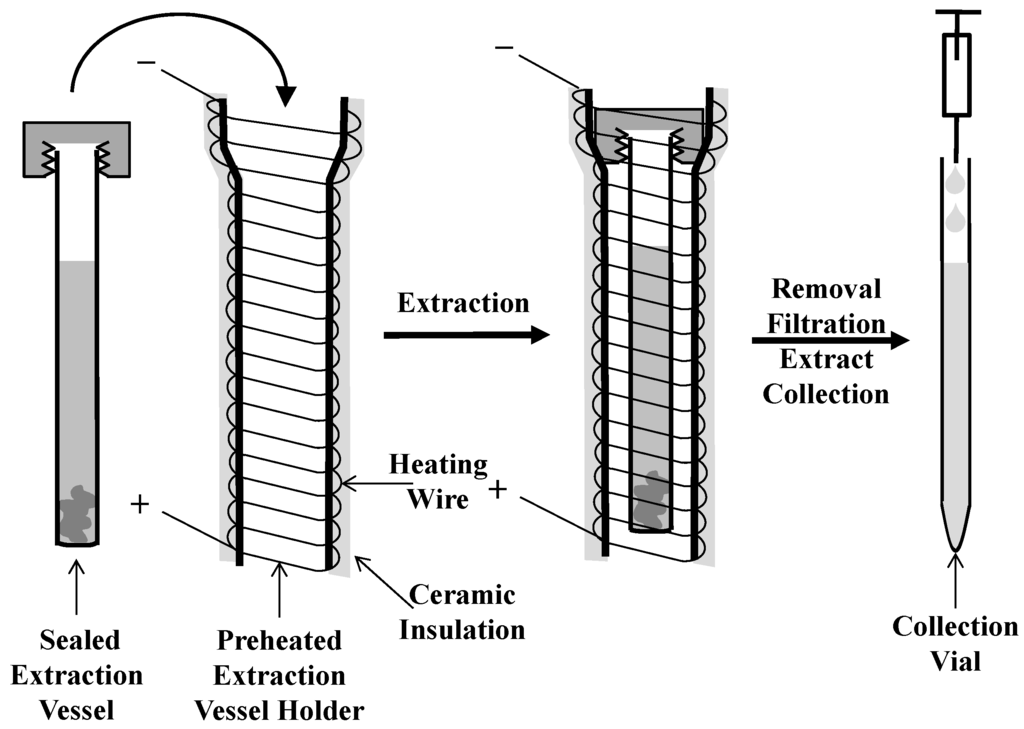
Figure 1
Open AccessArticle
An Improved Model for the Steric-Entropic Effect on the Retention of Rod-like Particles in Field-Flow Fractionation: Discussion of Aspect Ratio-Based Separation
by
Joontaek Park and Anand Mittal
Chromatography 2015, 2(3), 472-487; https://doi.org/10.3390/chromatography2030472 - 28 Jul 2015
Cited by 8
Abstract
We developed an improved model for predicting the steric-entropic effect on the separation behaviors of rod-like particles in flow field-flow fractionation. Our new model incorporates the “pole-vault” rotation of a rod-like particle near a wall under shear flow into the original model developed
[...] Read more.
We developed an improved model for predicting the steric-entropic effect on the separation behaviors of rod-like particles in flow field-flow fractionation. Our new model incorporates the “pole-vault” rotation of a rod-like particle near a wall under shear flow into the original model developed by Beckett and Giddings which considered only Brownian rotation. We investigated the effect of the aspect ratio on the retention ratios and the cross-sectional concentration distribution in the separation of rods in field-flow fractionation (FFF). Our analyses involved comparing the results predicted using the original model and those from the new model under various rod geometries and flow conditions. We found that the new model can show the aspect ratio-enhanced elution trend in certain flow conditions for the assumption of non-constant cloud thickness (ratio between the cross flow rate and the rod diffusivity). We also deducted that the flow conditions allowing for the aspect ratio-enhanced elution are related to the interplay among the axial flow rate, cloud thickness, and rod geometry. The new model can be viewed as a prototype to qualitatively show the aspect ratio-enhanced trend since its quantitative agreement with the experimental data must be improved for our future work.
Full article
(This article belongs to the Special Issue Field-Flow Fractionation)
►▼
Show Figures
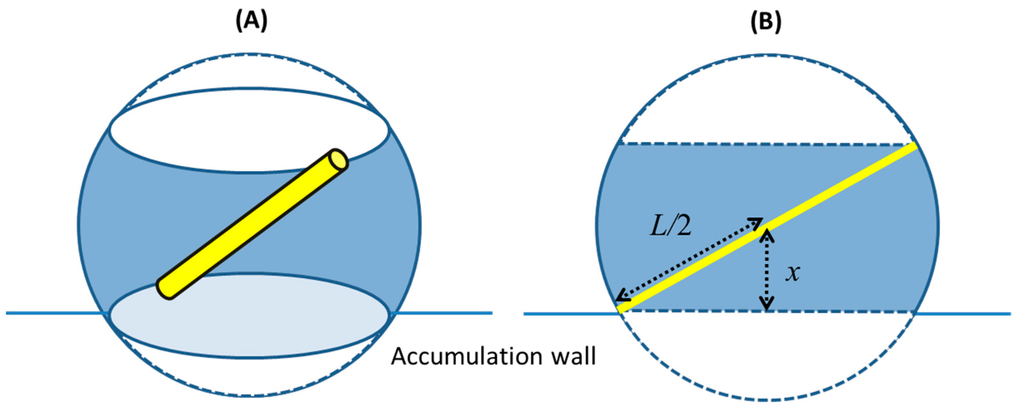
Figure 1
Open AccessArticle
Field-Amplified Sample Injection-Micellar Electrokinetic Chromatography for the Determination of Benzophenones in Food Simulants
by
Cristina Félez, Anna Molet and Oscar Núñez
Chromatography 2015, 2(3), 452-471; https://doi.org/10.3390/chromatography2030452 - 20 Jul 2015
Cited by 1
Abstract
A field-amplified sample injection-micellar electrokinetic chromatography (FASI-MEKC) method for the determination of 14 benzophenones (BPs) in a food simulant used in migration studies of food packaging materials was developed, allowing almost baseline separation in less than 21 min. The use of a 10
[...] Read more.
A field-amplified sample injection-micellar electrokinetic chromatography (FASI-MEKC) method for the determination of 14 benzophenones (BPs) in a food simulant used in migration studies of food packaging materials was developed, allowing almost baseline separation in less than 21 min. The use of a 10 mM sodium dodecyl sulfate (SDS) solution as sample matrix was mandatory to achieve FASI enhancement of the analyzed BPs. A 21- to 784-fold sensitivity enhancement was achieved with FASI-MEKC, obtaining limits of detection down to 5.1–68.4 µg/L, with acceptable run-to-run precisions (RSD values lower than 22.3%) and accuracy (relative errors lower than 21.0%). Method performance was evaluated by quantifying BPs in the food simulant spiked at 500 µg/L (bellow the established specific migration limit for BP (600 µg/L) by EU legislation). For a 95% confidence level, no statistical differences were observed between found and spiked concentrations (probability at the confidence level, p value, of 0.55), showing that the proposed FASI-MEKC method is suitable for the analysis of BPs in food packaging migration studies at the levels established by EU legislation.
Full article
(This article belongs to the Special Issue Electrophoretic Analyses in Capillaries and Microfluidic Devices)
►▼
Show Figures
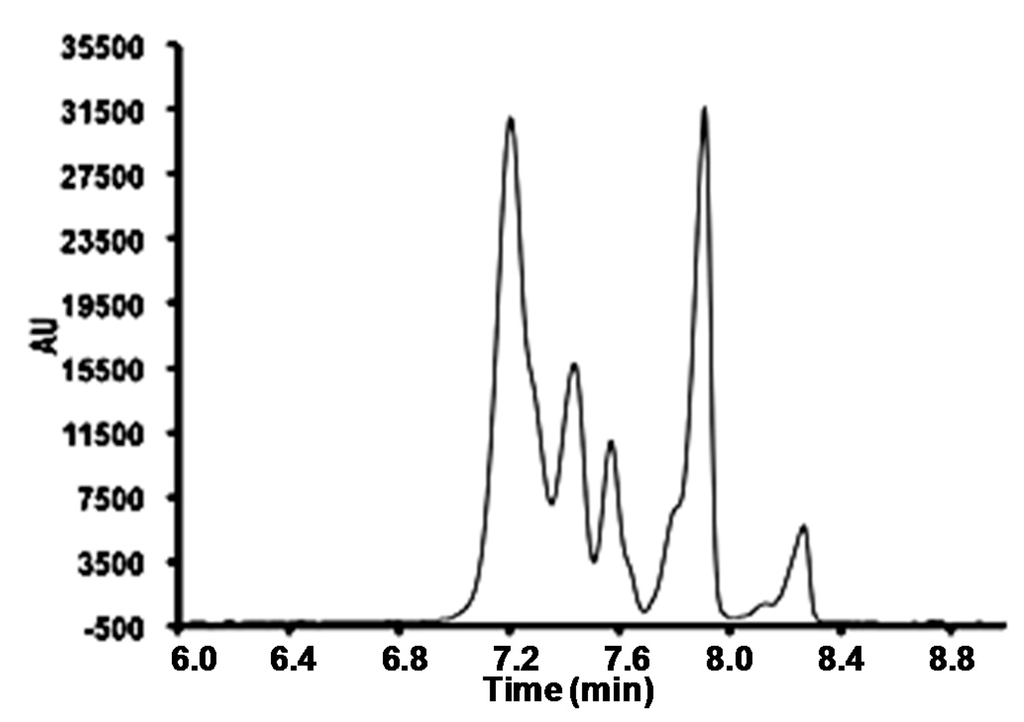
Figure 1
Open AccessArticle
Poly(N-isopropylacrylamide) Hydrogels for Storage and Delivery of Reagents to Paper-Based Analytical Devices
by
Haydn T. Mitchell, Spencer A. Schultz, Philip J. Costanzo and Andres W. Martinez
Chromatography 2015, 2(3), 436-451; https://doi.org/10.3390/chromatography2030436 - 17 Jul 2015
Cited by 13
Abstract
The thermally responsive hydrogel N,N'-methylenebisacrylamide-cross-linked poly(N-isopropylacrylamide) (PNIPAM) was developed and evaluated as a reagent storage and delivery system for microfluidic paper-based analytical devices (microPADs). PNIPAM was shown to successfully deliver multiple solutions to microPADs in specific sequences or simultaneously in
[...] Read more.
The thermally responsive hydrogel N,N'-methylenebisacrylamide-cross-linked poly(N-isopropylacrylamide) (PNIPAM) was developed and evaluated as a reagent storage and delivery system for microfluidic paper-based analytical devices (microPADs). PNIPAM was shown to successfully deliver multiple solutions to microPADs in specific sequences or simultaneously in laminar-flow configuration and was found to be suitable for delivering four classes of reagents to the devices: Small molecules, enzymes, antibodies and DNA. PNIPAM was also able to successfully deliver a series of standard glucose solutions to microPADs equipped to perform a colorimetric glucose assay. The results of these tests were used to produce an external calibration curve, which in turn was used to determine the concentration of glucose in sample solutions. Finally, PNIPAM was used to store the enzyme horseradish peroxidase for 35 days under ambient conditions with no significant loss of activity. The combination of PNIPAM and microPADs may allow for more complex assays to be performed on paper-based devices, facilitate the preparation of external calibration curves in the field, and extend the shelf life of microPADs by stabilizing reagents in an easy-to-use format.
Full article
(This article belongs to the Special Issue Microfluidic Paper-Based Analytical Devices)
►▼
Show Figures
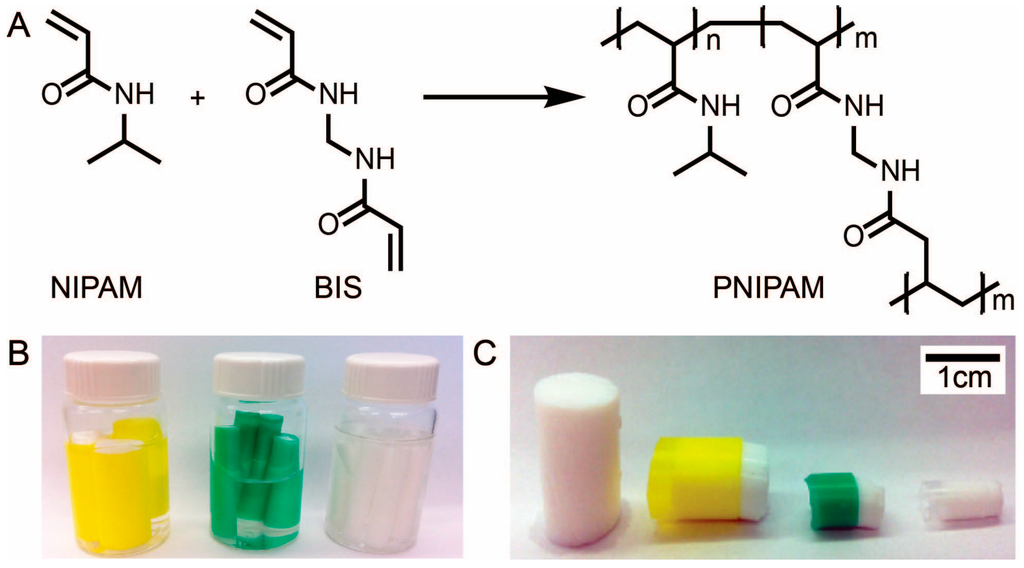
Figure 1
Open AccessCommunication
Fractionation and Characterization of High Aspect Ratio Gold Nanorods Using Asymmetric-Flow Field Flow Fractionation and Single Particle Inductively Coupled Plasma Mass Spectrometry
by
Thao M. Nguyen, Jingyu Liu and Vincent A. Hackley
Chromatography 2015, 2(3), 422-435; https://doi.org/10.3390/chromatography2030422 - 14 Jul 2015
Cited by 12
Abstract
Gold nanorods (GNRs) are of particular interest for biomedical applications due to their unique size-dependent longitudinal surface plasmon resonance band in the visible to near-infrared. Purified GNRs are essential for the advancement of technologies based on these materials. Used in concert, asymmetric-flow field
[...] Read more.
Gold nanorods (GNRs) are of particular interest for biomedical applications due to their unique size-dependent longitudinal surface plasmon resonance band in the visible to near-infrared. Purified GNRs are essential for the advancement of technologies based on these materials. Used in concert, asymmetric-flow field flow fractionation (A4F) and single particle inductively coupled mass spectrometry (spICP-MS) provide unique advantages for fractionating and analyzing the typically complex mixtures produced by common synthetic procedures. A4F fractions collected at specific elution times were analyzed off-line by spICP-MS. The individual particle masses were obtained by conversion of the ICP-MS pulse intensity for each detected particle event, using a defined calibration procedure. Size distributions were then derived by transforming particle mass to length assuming a fixed diameter. The resulting particle lengths correlated closely with ex situ transmission electron microscopy. In contrast to our previously reported observations on the fractionation of low-aspect ratio (AR) GNRs (AR < 4), under optimal A4F separation conditions the results for high-AR GNRs of fixed diameter (≈20 nm) suggest normal, rather than steric, mode elution (i.e., shorter rods with lower AR generally elute first). The relatively narrow populations in late eluting fractions suggest the method can be used to collect and analyze specific length fractions; it is feasible that A4F could be appropriately modified for industrial scale purification of GNRs.
Full article
(This article belongs to the Special Issue Field-Flow Fractionation)
►▼
Show Figures
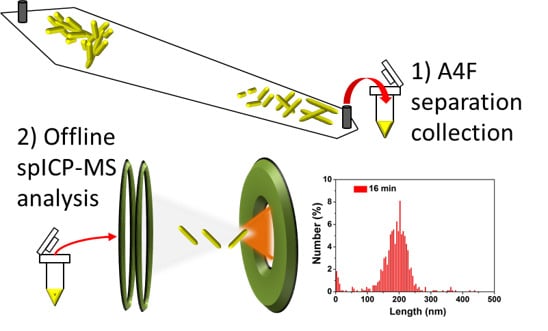
Graphical abstract
Open AccessArticle
Determination of Sesquiterpenes in Wines by HS-SPME Coupled with GC-MS
by
Fabrizio Cincotta, Antonella Verzera, Gianluca Tripodi and Concetta Condurso
Chromatography 2015, 2(3), 410-421; https://doi.org/10.3390/chromatography2030410 - 9 Jul 2015
Cited by 35
Abstract
The sesquiterpene compounds present in red wines were characterized and quantified by Headspace Solid-Phase Microextraction in combination with Gas Chromatography–Mass Spectrometry (HS-SPME-GC-MS). Sixteen sesquiterpenes were identified, mainly hydrocarbons but also derived oxygenated compounds. Sesquiterpenes were acyclic, monocyclic, byciclic and tryciclic. Sesquiterpenes were detected
[...] Read more.
The sesquiterpene compounds present in red wines were characterized and quantified by Headspace Solid-Phase Microextraction in combination with Gas Chromatography–Mass Spectrometry (HS-SPME-GC-MS). Sixteen sesquiterpenes were identified, mainly hydrocarbons but also derived oxygenated compounds. Sesquiterpenes were acyclic, monocyclic, byciclic and tryciclic. Sesquiterpenes were detected in SIM (selected ion monitoring) mode using their characteristics ions. All the sesquiterpenes were identified by mass spectral data, linear retention indices (LRI), literature data and injection of standards where available. Quantitative results were obtained using the method of standard additions. The method showed an average LOD = 0.05 µg L−1 and LOQ = 0.15 µg L−1. The monocyclic sesquiterpene with the germacrene skeleton, Germacrene D and the bicyclic sesquiterpene with the muurolane skeleton, α-muurolene were present in all the wine samples analysed. Syrah wines were the samples richest in sesquiterpenes in agreement with their typical spicy and woody notes. The results evidenced the possibility to use sesquiterpenes for wine authenticity and traceability.
Full article
(This article belongs to the Special Issue Solid Phase Micro-Extraction)
►▼
Show Figures
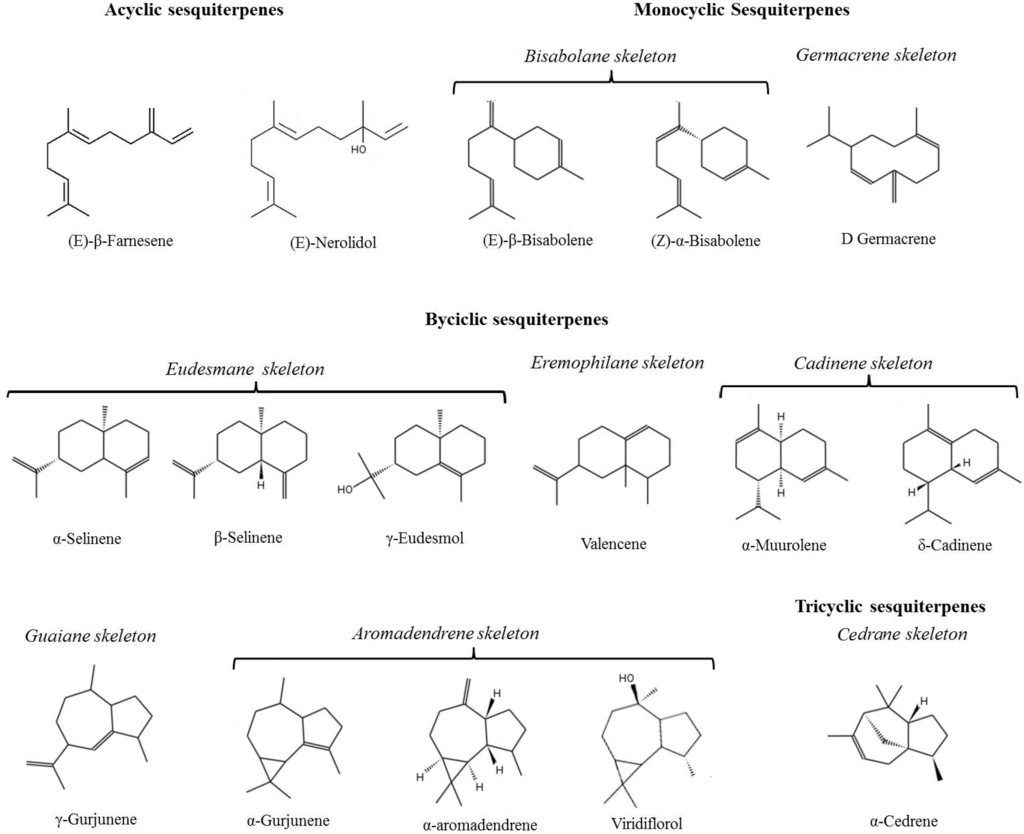
Figure 1
Open AccessArticle
Adverse-Mode FFF: Multi-Force Ideal Retention Theory
by
Tyler N. Shendruk and Gary W. Slater
Chromatography 2015, 2(3), 392-409; https://doi.org/10.3390/chromatography2030392 - 7 Jul 2015
Abstract
A novel field-flow fractionation (FFF) technique, in which two opposing external forces act on the solute particles, is proposed. When the two external forces are sufficiently strong and scale differently as a function of the solutes’ property of interest (such as the solute
[...] Read more.
A novel field-flow fractionation (FFF) technique, in which two opposing external forces act on the solute particles, is proposed. When the two external forces are sufficiently strong and scale differently as a function of the solutes’ property of interest (such as the solute particle size), a sharp peak in the retention ratio (dramatic drop in elution time) is predicted to exist. Because the external forces oppose one another, we refer to this novel technique as adverse-mode FFF. The location of this peak is theoretically predicted and its ideal width estimated. The peak can become quite sharp by simultaneously increasing the strength of both fields, suggesting that adverse-mode FFF could be a useful technique for accurately measuring single species solute size.
Full article
(This article belongs to the Special Issue Field-Flow Fractionation)
►▼
Show Figures

Figure 1
Highly Accessed Articles
Latest Books
E-Mail Alert
News
Topics






